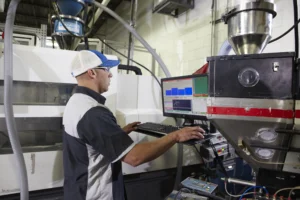By Steve Bieszczat, chief marketing officer, DELMIAWorks
Running a plastics processing operation – with its constant flow of materials, people, machinery and information – is one of the most demanding management jobs in the world. Without proper supervision and control, the operation can slip into inefficiencies and delays that drive up costs while lowering customer satisfaction. But for many plastics manufacturers, adding skilled people directly to manage every critical process can range from impractical to nearly impossible.
In fact, the Manufacturers Association for Plastics Processors (MAPP) noted in its State of the Plastics Industry Report 2023 that 86% of processors surveyed saw increasing employee wages as their biggest or second biggest challenge. The same report identified recruiting and retaining employees as the top fourth and fifth business challenges for plastics processors, overall.

To close the management gap, more plastics manufacturers are adopting a “management by exception” strategy that relies on automated processes and supervision to provide greater oversight and control without adding supervisory headcount. Let’s define management by exception, and then review some real-world examples of how plastics processors can apply this strategy to improve their performance.
Defining Management by Exception
Management by exception is a management style focused on identifying and resolving situations that deviate from normal or expected outcomes. It is a conscious decision to move away from rote supervision and instead emphasize trust in teams and systems to alert management of issues that require attention.
- In a plastics manufacturing operation, the four objectives of managing by exception are straightforward:
- Make sure current operations are running on plan.
- Spend as little time as possible inspecting what already is working.
- Address problems immediately before they create
bigger issues. - Dedicate more time to planning and executing
future improvements.
In adopting management by exception, plastics processors need to go beyond physical automation (i.e., assembly lines, robotics) and process automation (i.e., accounts payable, procurement) and step into an area that can best be described as management automation.
Management by exception in a manufacturing environment typically is implemented by using enterprise resource planning (ERP) and manufacturing execution system (MES) software, as the eyes and ears of the operation. These systems of operation are embedded with workflows, alerts and intelligence mechanisms that guide actions and monitor information streams and production processes.
With workflows and alerts in place, automated queries continuously can run in the background probing for next steps and identifying situations that require management intervention. The workflows are configurable systems of rules and routings that management establishes to guide and monitor daily processes. They trigger alerts when bottlenecks, missed steps or issues arise.
Most management teams start with a simple set of workflows and alerts. Then, as their confidence and proficiency grow, they build upon these initial rules ultimately creating a comprehensive rule-based management by exception program.
Common Management by Exception Manufacturing Scenarios
There are countless ways that management by exception can be applied to a manufacturing operation. The following are five real-world examples of how plastics processors apply it today to improve their performance.

Financial Management
Financial reporting is one of the earliest uses of management by exception. A great first step in the adoption of management by exception is setting up dashboards that provide alerts when key financial performance indicators are trending out of established ranges. Rather than requiring the management team to review financial reports on a daily basis, boundary triggers are set for desired key performance indicators (KPIs). If those KPIs go out of range, executive management immediately is notified. So, less time is spent monitoring actual versus plan, and no time is wasted in addressing issues.
Inventory Management
Inventory management is a fundamental value driver of ERP. Workflows and alerts increase that value. Here are two examples of how management by exception can improve inventory control.
First, consider an order with a short delivery timeframe that is submitted to the ERP system, which recognizes a shortage of the resin needed to fulfill the order. So, it creates a purchase order, but the lead time for acquisition is too long. Inventory triggers are alarmed by the misalignment, causing workflows and alerts to automatically push an expedited resin purchase to the top of the purchasing department’s to-do list.
In the second case, inventory levels for one resin have been sitting at max, with no further product movement. With triggers in place to compare slow-moving inventory to forecasted needs each quarter, the mismatch is detected. And the finance department automatically is advised that this resin on its books as an asset is no longer in demand and should be written down to a lower value. A hidden problem is discovered and corrected without costly manual audits.
Real-Time Production and Process Reporting
Even automated jobs frequently are monitored by an operator just in case an issue should arise, but some of the most common issues are hard for an operator to detect. Is the cycle rate slow? Is the pressure too high? This is why production monitoring, process monitoring and simple robotics have become the go-to management by exception approach for automating repetitive production work centers.
Robots pack the boxes. Sensors monitor the technical parameters. Alerts monitor the sensors, and except when an issue is detected, the bulk of the job can run labor free. So, all the time and energy previously spent monitoring a well-running job is eliminated.
Additionally, automated systems record all the data of real value, such as production rates, process parameters and material consumption, and should anything go wrong, they immediately notify the proper personnel.
Quality Inspection
A good example is in-line quality inspection for a micro-molding operation making medical-grade tubing connectors at the rate of 200 pieces per hour. The operator needs to inspect two pieces every 10 minutes to ensure that the connectors’ grip strength is between seven to 10 lbs and record the results. Manually recorded results open multiple possible avenues for error. An operator might skip cycles and record partial results, be distracted from taking accurate measurements, or not even realize measurements are needed in the first place. This means a quality supervisor needs to periodically check on the operator to ensure tests are being performed as specified.
With management by exception, a workflow in the MES notifies the operator of the need to take periodic measurements when logging on to the job. Additionally, the workstation operator screen (a human-machine interface) provides a tool to input the test results, and it time stamps the entries. Meanwhile, the rules engine knows to alert supervision if measurements are not regularly occurring or are outside specified limits. As a result, a correctly run job requires no intermediate supervision, and any issue with testing immediately is identified.
Back-Filling Important Roles
Back-filling important roles is easier with a management by exception strategy. Consider the situation where a key supervisor unexpectedly has taken medical leave. In a traditional operation managed by direct supervision and institutional knowledge, the general manager suddenly is faced with a number of essential supervisory steps that may or may not happen.
However, if management by exception has been adopted, the general manager is in an entirely better situation for two key reasons. First, any supervisory steps not being performed will trigger alerts for the general manager to take remedial action and ensure nothing is forgotten. Second, because the business has taken the time to codify the production processes and assign responsibility for each step, the general manager proactively can see exactly what tasks typically are handled by the absent supervisor and automatically re-assign those tasks to different individuals.
Conclusion
To remain competitive, plastics processors need to move from a high dependency on continuous oversight and tribal knowledge to management systems based on ordered processes that are recorded, institutionalized and implemented by automated systems. As the scenarios above illustrate, the thought process and a philosophy of management by exception practically can be implemented by taking advantage of the automated workflow and alert features found in modern ERP and MES solutions. By leveraging these technologies to drive more of their operations through management by exception, plastics manufacturers can build greater sustainability, resilience, agility and financial performance into a business.
Steve Bieszczat, chief marking officer, is responsible for DELMIAWorks brand management, demand generation and product marketing. Prior to DELMIAWorks, He held senior marketing roles at ERP companies IQMS, Epicor and Activant Solutions. Bieszczat’s focus is on aligning products with industry requirements as well as positioning DELMIAWorks with the strategic direction and requirements of the brand’s manufacturing customers and prospects. Bieszczat holds an engineering degree from the University of Kansas and an MBA from Rockhurst.
More information: www.solidworks.com/delmiaworks-manufacturing-erp





